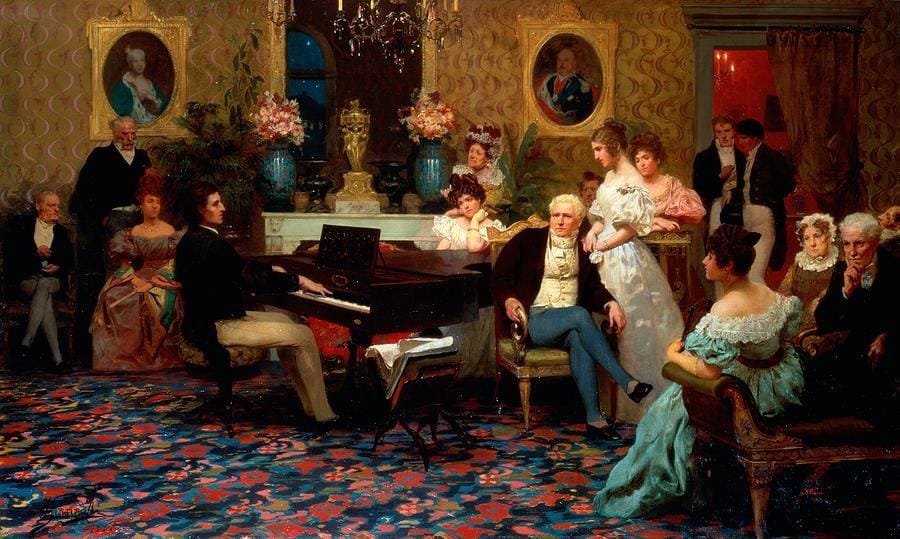Tales of Melody and Mischief: The ‘Minute’ Waltz and the Dogs of Chopin

My son’s piano lessons with Prof. Margarida Miranda are an education of sorts for me too. I get a chance to study piano scores more closely and better understand the inner workings of a composition.
Lately he’s learning the Waltz in D-flat major, Op. 64, No. 1 by Polish virtuoso pianist-composer Frédéric Chopin (1810 – 1849). Written in 1847, it is dedicated to Countess Delfina Potocka, “noted for her beauty, intellect and artistic gifts”. She was Chopin’s piano student and later his friend and muse.
The popular nickname of the piece is the ‘Minute’ Waltz. But the performances of even the flashiest pianists take longer than a minute.
YouTube videos take up the implied “challenge” of playing all the notes within a minute. One performer does it in 57 seconds, but it really isn’t music, just a parlour trick.
The “Minute” was never a reference to time but to size; the waltz is “minute” in the sense of being a miniature piece, and a delightful one when played with elegance and humour.
Why humour? The clue is in the French nickname: ‘Le petit chien’ (The little dog, or puppy). There hang a little tale and tail!
In a previous column I mentioned Chopin’s heartbreak at his broken “engagement” (formal or otherwise) to Maria Wodsińska in 1837.
A year before, he had met the French novelist, memoirist and journalist Amantine Lucile Aurore Dupin de Francueil, better known as George Sand (1804-12879) at a party. She didn’t make a great first impression on him.
She was short (under five feet), “dark and big-eyed.” She wore men’s clothing “without a permit”, justifying it as being more comfortable, less expensive and far sturdier than the typical dress of a noblewoman at the time. And she smoked large cigars.
“What an unattractive person la Sand is. Is she really a woman?” he is said to have remarked. But by the end of June1838 they had become lovers.
In 1840 Chopin and Sand decided to adopt a stray dog that had followed Chopin home on the streets of Paris. She described the incident in a letter to her son Maurice:
“This morning we have acquired a delightful little puppy, no bigger than a fist, dark brown, with a white waistcoat, white stockings in front and white shoes on the hind legs. This gentleman followed Chopin in the street, and simply would not leave him. Then, oh miracle, Chopin took the little dog in adoration and has spent the whole day looking after it, even though it did its “something” in the drawing room and gave us all fleas. Chopin finds this charming, mainly because the dog is all over him and cannot stand Solange [Sand’s 12-year-old daughter]. Solange is fiercely jealous. At this moment the little thing is sleeping at my feet. It has been called Mops, which is, quite simply, the Polish for Pug.” [Paris, 20 September 1840].
We can’t say what happened to Mops. But by the mid-1840s, Sand and Chopin moved to Paris’ fashionable Square d’Orleans and Sand acquired two dogs, named Marquis and Dib.
Nohant, George Sand’s country home (a chateau 100 miles south of Paris) had become a valuable haven for Chopin, and in the seven summers he spent there he had composed some of his greatest music.
On 11 October 1846, he wrote from there to his family in Warsaw: “The little dog Marquis (you remember) is staying with me and is lying on my sofa. He is an extraordinary creature: he has a soft fluffy white coat which Mme Sand herself brushes every day, and he is as intelligent as can be. I can’t begin to tell you all his original tricks. For example, he will neither eat nor drink from a gilt vessel: he pushes it away with his nose and upsets it if he can.”
Sand and her two children would put on plays and puppet theatre at Nohant, on a small stage with pieces of painted scenery. Chopin joined in the fun by providing the music. A musical sketch, ‘Gallop Marquis’ has survived, a light-hearted bagatelle. Its second section (over the thirteenth and fourteenth bars) has the annotation in Chopin’s hand: “partie Dib.”
These little vignettes show how much they loved their dogs.
Chopin completed his last great piano masterpieces, the Barcarolle, Polonaise-Fantaisie and two Nocturnes Op.62 at Nohant in 1846.
Om 25 November 1846, after he had returned to Paris (unaware that he would never go back to Nohant), Chopin wrote to her: “Please thank Marquis for missing me and for sniffing at my door.” A lot of their correspondences refer to the antics and well-being of Marquis and Dib.
By the next year (the year the waltz was written) however, the relationship between Sand and Chopin was over. Two years later, Chopin would be dead, and Sand would be conspicuous by her absence at his funeral.
But at some happy point in their relationship, the story goes that Marquis was energetically preoccupied in chasing his own tail while the couple watched amusedly. Sand apparently said to Chopin, “If I had your talent, I would compose a piano piece for this dog.”
And so he did, but in what would prove to be his twilight years, when his general state of health, his physical, emotional and mental state of wellbeing were at their lowest ebb. He was plagued by loneliness and tuberculosis, but despite it (or perhaps because of it) was able to conjure up a reminder of better times.
Chopin uses an ingenious musical device to portray the vigorous tail-chasing. For the first four measures only the right hand plays what is essentially four notes repeated in a loop: two notes going up, followed by another two notes descending. Then the left hand establishes the waltz rhythm, but this creates tension between the 1-2-3 of the left hand in quarter-notes, and the 1-2-3-4 in eighth-notes in the right hand. It happens for just three bars, after which the right hand breaks free from the motif to soar as if flung into the air. The sequence is repeated, and then the tail-chasing motif begins to ascend the register followed by descending and ascending passages in carefree abandon.
The ’tail’ is momentarily forgotten in the central section, a simple, lightly embellished melody, with a bell-like high acciaccatura (grace note) ornamenting it the second time round. The ‘question’ at the end leads to a trill, the perfect segue to a recap of the first ‘tail-chasing’ idea with a graceful romp to the finish, but not before a gymnastic leap to F7, three octaves above middle C, and a dizzying scalar descent down to ‘earth’ again, the tonic note of D flat a half-tone above middle C.
That high F was the upper limit of Chopin’s piano of the time. It is as if his creativity wis chafing at the confines of his instrument.
Let Marquis come to life the next time you hear or play this little tribute to puppy love.
This article first appeared in The Navhind Times, Goa, India.





